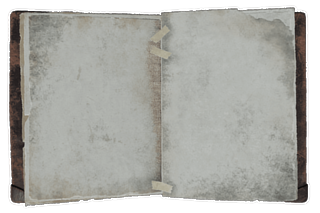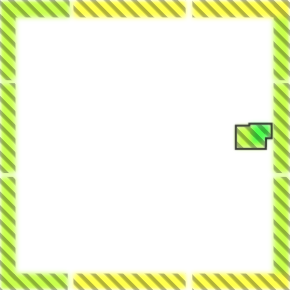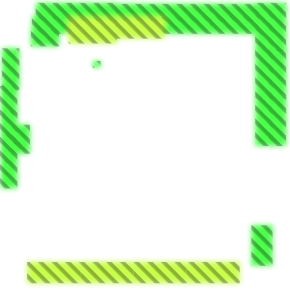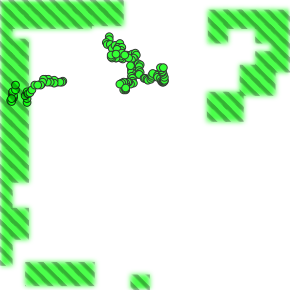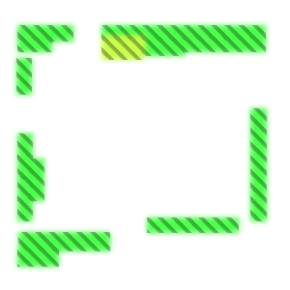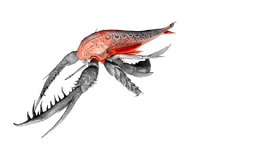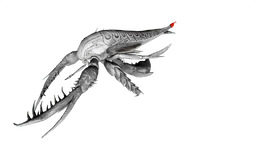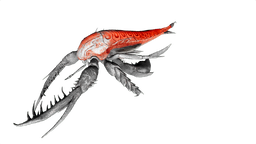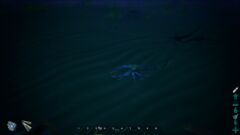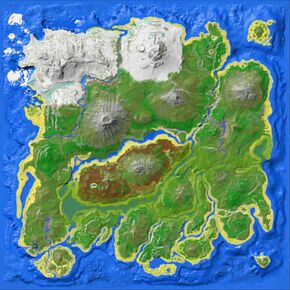
Eurypterid
cheat summon Euryp_Character_Cor
cheat SpawnDino "Blueprint'/Game/PrimalEarth/Dinos/Eurypterid/Euryp_Character.Euryp_Character'" 500 0 0 35

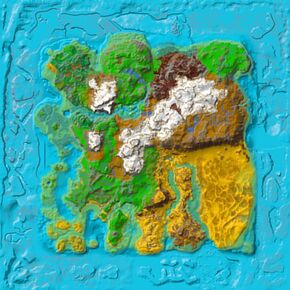


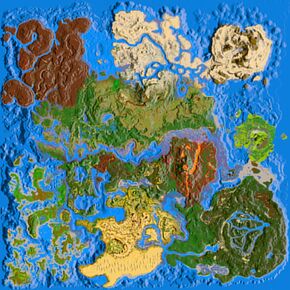


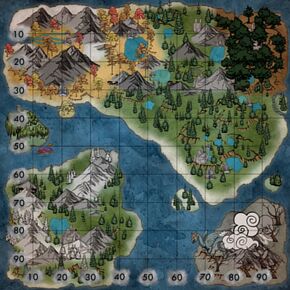
Untameable Cave
The Eurypterid (you-rip-teh-rid), sometimes referred to as Sea Scorpion, is one of the creatures in ARK: Survival Evolved.
Basic Info
Dossier
This section is intended to be an exact copy of what the survivor Helena Walker, the author of the dossiers, has written. There may be some discrepancies between this text and the in-game creature.
Jaekelopterus eurypterus
TimeSilurian
DietCarnivore
TemperamentAggressive
- Wild
Found only in the deepest depths of the waters around the Island, Eurypterids are dangerous and adaptable arthropods. As likely to hunt as they are to scavenge, a Eurypterid rarely has difficulty finding food to keep itself nourished, even at the bottom of the ocean.
An Eurypterid's threat comes not directly from its raw strength. Instead, it combines a hard defensive exoskeleton with debilitating poison to powerful effect. The sting of a Eurypterid increases ![]() Torpor while reducing stamina, quickly rendering its opponent unable to defend itself.
Torpor while reducing stamina, quickly rendering its opponent unable to defend itself.
- Domesticated
While Eurypterids are not intelligent enough to be tamed, this doesn't mean they are without utility to tribes. They are a wonderful source of chitin, and their digestive tract often contains Silica pearls. They sometimes even have ingested incredibly rare Black Pearls, used by survivors for advanced manufacturing, making them among the most valuable creatures on the island.
Behavior
The Eurypterid moves silently along the floor of the ocean, slowly undulating its body to move through the waterways. Since they spawn in clusters of two to four, there will often be many in a single area, often around coral and seaweed in the depths. When a player approaches the area to hunt for ![]() Silica Pearl clams or for the Eurypterids themselves, the Eurypterids will swim towards the invader and attack. They can envenom the survivor, knocking them out before dispatching the paralyzed body. In Genesis Part 2, they can be found in shallow waters or even on shorelines. It is unclear if this is intended or not
Silica Pearl clams or for the Eurypterids themselves, the Eurypterids will swim towards the invader and attack. They can envenom the survivor, knocking them out before dispatching the paralyzed body. In Genesis Part 2, they can be found in shallow waters or even on shorelines. It is unclear if this is intended or not
Appearance
Superficially resembles a ![]() Pulmonoscorpius with adaptations to fit an aquatic lifestyle. The entire animal is armored with a
Pulmonoscorpius with adaptations to fit an aquatic lifestyle. The entire animal is armored with a ![]() Chitinous exoskeleton. The body is made up of the front "head", or the prosoma, and the segmented body and tail, or the mesosoma and metasoma respectively which together make up the opisthosoma. Its rearmost 4th pair of legs are flattened into flippers and its tail moves in an up and down motion, being propelled by a tail fluke. The end of the tail bears a scorpion-like venomous stinger. The 3rd pair of legs are long and skinny, followed by the thick, highly segmented 2nd pair of legs. The 1st pair of forelimbs are large and strong, armed with formidable spines which can close as a vice to trap and shred prey. 2 arm-like chelicerae rest at the front of the animal, which manipulate food to the mouth. Two small, beady compound eyes are also present on the head. Range of coloration is currently unknown.
Chitinous exoskeleton. The body is made up of the front "head", or the prosoma, and the segmented body and tail, or the mesosoma and metasoma respectively which together make up the opisthosoma. Its rearmost 4th pair of legs are flattened into flippers and its tail moves in an up and down motion, being propelled by a tail fluke. The end of the tail bears a scorpion-like venomous stinger. The 3rd pair of legs are long and skinny, followed by the thick, highly segmented 2nd pair of legs. The 1st pair of forelimbs are large and strong, armed with formidable spines which can close as a vice to trap and shred prey. 2 arm-like chelicerae rest at the front of the animal, which manipulate food to the mouth. Two small, beady compound eyes are also present on the head. Range of coloration is currently unknown.
Color Scheme and Regions
This section displays the Eurypterid's natural colors and regions. For demonstration, the regions below are colored red over an albino Eurypterid. The colored squares shown underneath each region's description are the colors that the Eurypterid will randomly spawn with to provide an overall range of its natural color scheme. Hover your cursor over a color to display its name and ID.
This information can be used to alter the Eurypterid's regions by entering cheat SetTargetDinoColor <ColorRegion> <ColorID> in the cheat console. For instance, cheat SetTargetDinoColor 0 6 would color the Eurypterid's "cephalothorax and tail flippers" magenta.
Drops
Base Stats and Growth
| Attribute | Base Value | Level Increase |
|---|---|---|
| Wild | ||
| 160 | +32 | |
| 100 | +10 | |
| N/A | N/A | |
| 450 | +45 | |
| 150 | +3 | |
| 7 | +0.35 | |
| 100% | N/A | |
| 50 | +3 |
- For a comparison of the stats of all creatures, see Base Creature Statistics.
- For an explanation of exactly how the levelup calculation works, see Creature Stats Calculation.
- 1These are the base speeds of the tamed creature at 100% Movement Speed, i.e. without a possible taming bonus.
- 2These are the speeds of the creature once tamed including a possible taming bonus and no imprinting bonus.
- For a comparison of the speeds of all creatures, see Base Creature Speeds.
Abilities
Active
| Sting |
|
|---|
Combat
This section describes how to fight against the Eurypterid.
General
Eurypterids will spawn quite rarely along the ocean floor in small clusters of 2-4. They are rather small, but they can still pack a punch, as their attacks are fairly strong and rapidly raise ![]() Torpidity!
Torpidity!
Strategy
The first step is locating a Eurypterid. They remain relatively hidden in the coral and seaweed underwater, so they are quite hard to find. Once found, construct a plan on how to attack without subjecting any players to the deadly poison they employ in their attacks, which can drain stamina and induce high amounts of ![]() Torpor. Sea mounts can be used to stay safe during killing, but large creatures cause a heavy knockback on the Eurypterids, so the area of effect loses efficiency and damage stops are enforced. The
Torpor. Sea mounts can be used to stay safe during killing, but large creatures cause a heavy knockback on the Eurypterids, so the area of effect loses efficiency and damage stops are enforced. The ![]() Ichthyosaurus surprisingly can be used to farm the Eurypterids, because it is immune to Torpor and has no knockback, which effectively increases the damage against the Eurypterids since they will never try to flee and stay in range, keep in mind that the Eurypterids will still deal normal damage to it. The
Ichthyosaurus surprisingly can be used to farm the Eurypterids, because it is immune to Torpor and has no knockback, which effectively increases the damage against the Eurypterids since they will never try to flee and stay in range, keep in mind that the Eurypterids will still deal normal damage to it. The ![]() Tusoteuthis and
Tusoteuthis and ![]() Basilosaurus are also immune to Torpor and can farm them at a great rate.
Basilosaurus are also immune to Torpor and can farm them at a great rate.
A strategy that's only recommended for players with the ![]() SCUBA Gear:
SCUBA Gear:
Swim down to the bottom of the ocean where the Eurypterids hide, then once you find some, swim upwards. These creatures can not leave the ocean floor, so you can safely float above them and shoot them down with a crossbow. Once you've killed them, swim down and safely collect their corpses with a ![]() Metal Hatchet. If one desires their rare
Metal Hatchet. If one desires their rare ![]() Black Pearls, be sure to collect their bodies with a
Black Pearls, be sure to collect their bodies with a ![]() Metal Pick.
Metal Pick.
Weaponry
Employ any weaponry that, in use, will keep a player out of range of the tranquilizing attacks they deal. A ![]() Pike can be used by more alert, daring survivors who have powerful melee damage. Otherwise, mounts and ranged weapons like the
Pike can be used by more alert, daring survivors who have powerful melee damage. Otherwise, mounts and ranged weapons like the ![]() Crossbow or
Crossbow or ![]() Harpoon Launcher are your best shot.
Harpoon Launcher are your best shot.
Dangers
Eurypterids are small enough to be easily hidden in the ocean's many plants and reefs. Use caution when collecting pearls, as their venom causes extreme amounts of ![]() Torpor, while their actual damage is low, they can even render larger creatures unconscious easily. This can turn a simple collection mission on its head quickly. You might also aggro more powerful aquatic dinos such as
Torpor, while their actual damage is low, they can even render larger creatures unconscious easily. This can turn a simple collection mission on its head quickly. You might also aggro more powerful aquatic dinos such as ![]() Megalodon or
Megalodon or ![]() Mantas
Mantas
Weakness
Eurypterids float barely above the seafloor, but cannot freely swim in the open water. They also have low ![]() Health, so bringing a large sea mount guarantees their death.
Health, so bringing a large sea mount guarantees their death.
Utility
Roles
- Harvestable Resources: The Eurypterid can not be tamed and due to their rarity they cannot be brought together in large enough numbers to cause harm to other tribes. However, they do provide a bountiful amount of resources when gathered, including fairly valuable ones like
 Silica Pearls,
Silica Pearls,  Chitin, and
Chitin, and  Oil as well as rare
Oil as well as rare  Black Pearls needed for high-tech equipment. The
Black Pearls needed for high-tech equipment. The  Trilobite also yields such items albeit at a much lower amount of Pearls and Oil.
Trilobite also yields such items albeit at a much lower amount of Pearls and Oil. - River Access: Despite the Eurypterid being a deep creature and being untamable a survivor can lure one or a few onto shallow water due to their small size. Because they are smaller than the other animals found in the sea Eurypterid follow survivors up rivers and be used to attack enemies. Unlike other aquatic creatures, shallow waters don't limit where Eurypterid can go.
Spotlights
Notes/Trivia
For information pertaining specifically to the real-world Eurypterid, see the relevant Wikipedia article.
- The Eurypterid was first revealed by Drake on 09/08/2015 [1]
- The Dossier was revealed on 09/10/15 on Steam.[2]
- Although it is difficult and there is no purpose for doing so, Eurypterids can be lured to shore where they will strangely swim — almost hovering — in the air. This is most likely a bug.
- In The Ragnarok map they are known to swim out of the waters of Viking Bay, which is quite shallow and near the shore, and tranquilize and eat survivors.
- Eurypterids can be observed doing this naturally along the forest floor in many of the Ocean Biome's Terrariums in Genesis: Part 1. Interestingly, they are the only creature, hostile or otherwise, that spawn inside the Terrariums at all.
- Most real life Eurypterids did not bear stingers as the dossier depicts. Most had tails ending in blade-like shapes, although some had flattened 'flukes' to help propel themselves through water. However, some members of the superfamily, Carcinomatosa, did have stingers used to inject venom into prey.
- Eurypterids were once thought to have been most closely related to horseshoe crabs, as opposed to Arachnids like scorpions. However, this taxonomy has been challenged, with some scientists proposing the close grouping of eurypterids and horseshoe crabs as paraphyletic and thus unnatural and that the Eurypterids are more closely related to arachnids; others still argue that the original grouping is correct. Despite this classification debacle, all 3 creatures were still fairly closely related to one another, with all of them belonging to Prosomapoda, which is a clade within Arachnomorpha, which in turn is a clade within Arthropoda.
- Eurypterids are a broad group with many members. According to the dossier, ARK's Eurypterids are from the genus Jaekelopterus - in real life, these were the largest arthropods ever known to evolve, at 2.5 m (~8 feet) in length.
- The genus Jaekelopterus was the largest genus of Eurypterid, but in ARK, the species is called Jaekelopterus eurypterus, which isn't actually a real species that existed. Jaekelopterus was a genus of eurypterid in the family Pterygotidae, whereas the genus Eurypterus (not a species) was a part of the family Eurypteridae.
- Even though the ARK Eurypterid is said to be a part of the Jaekelopterus genus, it seems to combine physical traits from the genera Megalograptus and Mixopterus. Jaekelopterus had far less appendages and had two appendages on the prosoma (upper-most segment on the body) with claws similar to modern crustaceans such as lobsters. The eurypterids in ARK, however, even though they are similar in size to Jaekelopterus, have long appendages on the prosoma covered in large spines with many other appendages such as paddles used for locomotion which is far more similar to the genus Megalograptus, who possessed these features. The genus Mixopterus had similar spined appendages and also the scorpion-like 'stinger' found on the ARK Eurypterids.
Changelog
| Patch | |
|---|---|
| 238.0 | |
| 238.2 | Increased spawn frequency by 60%. |
| 254.5 | Can no longer receive buffs or debuffs. |
| 260.0 | Increased spawn numbers by 50%. |
| 262.0 | More Eurypterids are now present in the underwater overworld. |
Gallery
References
- ↑ Eurypterid!
- ↑ Jat (10 September 2015). "Introducing the Eurypterid!". Announcements. ARK: Survival Evolved Steam Community. Retrieved September 10, 2015.
| Creatures |
|---|
- Pages setting LuaCache keys
- Invertebrates
- Carnivores
- Aggressive creatures
- Creatures released in v238
- Creatures released in 2016
- Creatures released in v733
- Creatures released in v501
- Creatures released in v521
- Creatures released in 2018
- Creatures released in Mobile v1
- Untameable creatures
- Unbreedable creatures
- Creatures that are immune to torpor
- Creatures that don't drop feces
- Creatures
- Aquatic

